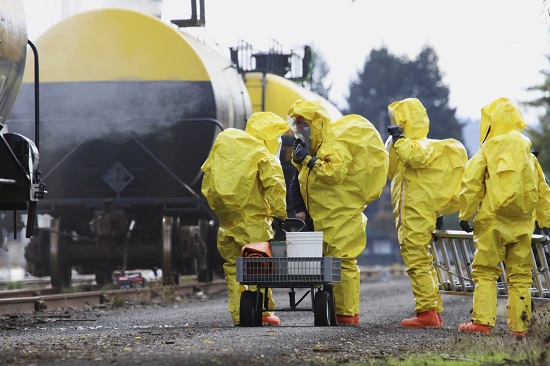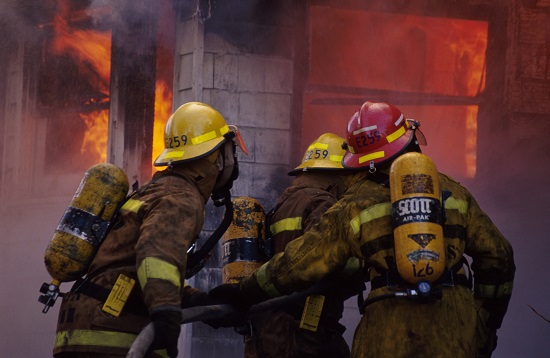From highest highs to lowest lows
The median annual wage for most of the occupations in table 1 was higher than the $35,540 median wage for all occupations in May 2014, according to BLS. In addition to providing good wages, intense or action-packed careers are often interesting and fulfilling, say workers in these occupations.
But the stress can take a toll, and despite workers’ best efforts, there is no guarantee things will go as planned. “There are always those situations that don’t have the happy ending we all hope for,” says Blake Govan, a police dispatcher in Detroit, Michigan. “That’s hard to deal with, and you may even second-guess your decision making.”
| Occupation | Employment, 2014 | Median annual wage, May 2014(1) |
|---|---|---|
|
Protect the public |
||
|
Correctional officers and jailers |
457,600 | $39,780 |
|
Detectives and criminal investigators |
116,700 | 79,870 |
|
Firefighters |
327,300 | 45,970 |
|
Police and sheriff’s patrol officers |
680,000 | 56,810 |
|
Security guards |
1,095,400 | 24,410 |
|
Save lives |
||
|
Ambulance drivers and attendants, except emergency medical technicians |
19,600 | 24,080 |
|
Emergency medical technicians and paramedics |
241,200 | 31,700 |
|
Physicians and surgeons |
708,300 | ≥187,200 |
|
Police, fire, and ambulance dispatchers |
102,000 | 37,410 |
|
Registered nurses |
2,751,000 | 66,640 |
|
Encounter danger or adventure |
||
|
Explosives workers, ordnance handling experts, and blasters |
8,100 | 52,140 |
|
Fishing and hunting workers |
28,400 | 32,530 |
|
Hazardous materials removal workers |
43,700 | 38,520 |
|
Military careers(2) |
N/A | N/A |
|
Self-enrichment education teachers |
348,700 | 36,020 |
|
Footnotes: |
||
|
Source: U.S. Bureau of Labor Statistics |
||
Schedules may be long and grueling, with some workers regularly having 10- or 12-hour shifts that include nights, weekends, or holidays. And in many of these occupations, injury, illness, and fatality rates are higher than average.
To reduce risk factors, workers take precautions, such as by wearing protective gear or adhering to workplace safety guidelines. Still, their jobs may expose them daily to disease, suffering, or other physically and emotionally taxing situations.

Support from colleagues helps these workers persevere through the hardships. And many are driven by a desire to succeed amid challenges. Working through difficult situations is important, says Sharp—especially when giving up is not an option. Wagner agrees. “You can’t get upset or shaken up,” he says. “You just do your job.”
The variety of work in many of the occupations is also a plus. “Every day is an adventure,” says Govan. But perhaps the greatest reward is the opportunity to have a positive effect on others. “When you go home, you feel like you’ve served a purpose,” says Kevin Stuart, a correctional officer in Brazos County, Texas. “That’s really satisfying.”
Getting started
Workers in high-intensity jobs say it takes a lot more than a desire for action or excitement to succeed in these occupations.
For starters, you must be adaptable and perform well under pressure. Good judgment and self-control are also important. And the ability to communicate with all types of people is essential, as is following protocol. “When you take shortcuts, that’s when things become risky,” says Stuart.
In addition, some combination of education, training, or other preparation is typically required for entry. (See table 2.)
| Occupation | Typical education needed for entry | Work experience in a related occupation | Typical on-the-job training needed to attain competency in the occupation |
|---|---|---|---|
|
Protect the public |
|||
|
Correctional officers and jailers |
High school diploma or equivalent | None | Moderate-term on-the-job training |
|
Detectives and criminal investigators |
High school diploma or equivalent | Less than 5 years | Moderate-term on-the-job training |
|
Firefighters |
Postsecondary non-degree award | None | Long-term on-the-job training |
|
Police and sheriff’s patrol officers |
High school diploma or equivalent | None | Moderate-term on-the-job training |
|
Security guards |
High school diploma or equivalent | None | Short-term on-the-job training |
|
Save lives |
|||
|
Ambulance drivers and attendants, except emergency medical technicians |
High school diploma or equivalent | None | Moderate-term on-the-job training |
|
Emergency medical technicians and paramedics |
Postsecondary non-degree award | None | None |
|
Physicians and surgeons |
Doctoral or professional degree | None | Internship/residency |
|
Police, fire, and ambulance dispatchers |
High school diploma or equivalent | None | Moderate-term on-the-job training |
|
Registered nurses |
Bachelor’s degree | None | None |
|
Encounter danger or adventure |
|||
|
Explosives workers, ordnance handling experts, and blasters |
High school diploma or equivalent | Less than 5 years | Long-term on-the-job training |
|
Fishers and related fishing workers |
No formal educational credential | None | Moderate-term on-the-job training |
|
Hazardous materials removal workers |
High school diploma or equivalent | None | Moderate-term on-the-job training |
|
Military careers(1) |
Varies, but at least a high school diploma or equivalent | Varies | Varies |
|
Self-enrichment education teachers |
High school diploma or equivalent | Less than 5 years | None |
|
Footnotes: |
|||
|
Source: U.S. Bureau of Labor Statistics |
|||
Education
To enter most of the occupations mentioned in this article, you’ll need a high school diploma or the equivalent. But even then, employers may prefer to hire workers with additional education. Only fishing workers typically can enter their occupation without a formal educational credential.
Among the occupations that typically require higher levels of education for entry are firefighters (certificate or other post-secondary non-degree award), registered nurses (bachelor’s degree), and doctors (professional degree.)

Training
Performing well in high-stress situations requires a certain level of competency, which is frequently honed while training on the job. Table 2 shows the length of this training typically needed once employed in an occupation.
Security guards, for example, typically need no more than 1 month of on-the-job experience and informal training.Hazardous materials removal workers are among those who may need up to 12 months of training. And firefighters and explosives workers usually develop their skills on the job for more than a year.
In some occupations, such as those in protective service, workers attend special training academies after being hired. Graduates from these training academies then receive additional on-the-job training at their own facility.
Other requirements
Like workers in other occupations, those in high-intensity jobs must meet a variety of additional requirements. To become an entry-level criminal investigator, for example, you typically need work experience as a police officer. And in many of these occupations, such as registered nurse, workers need a professional license.

Still other qualifications might include age requirements, U.S. citizenship, and a valid driver’s license, as well as passing a physical exam, drug screening, or background check.
Because of the unique rigors of these jobs, you may want to experience the work firsthand before pursuing a career. You might, for example, do a ride-along with an ambulance driver or shadow a fishing worker. Internships are also helpful.
In fact, there may be lots of ways to get a sense for what these workers do. Govan first became interested in emergency response work after his uncle gave him a police scanner, so he could listen in on the action. He became so intrigued, he asked to do a sit-along at a local 9-1-1 center, which confirmed his passion. “That’s what grasped me and got me addicted to the job,” he says.
For people who thrive on action, their attraction to these occupations may differ. But high-stakes careers often have at least one thing in common: The daily uncertainty offers a chance to develop as a person. “I still learn new things,” says Sharp. “You can always keep growing.”
Original post appeared on www.bls.gov.






